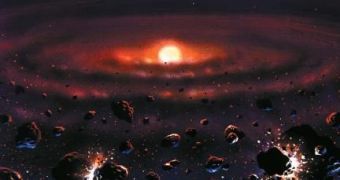Most astronomers believe that our solar system formed from the gravitational collapse of a giant molecular cloud, which was likely several light-years across and probably birthed several stars. But a new find contradicts that nebular hypothesis, saying it wasn't a black hole that gave birth to the Sun and the planets.
Analysis of a strange meteorite suggested that a supernova, that was supposed to have formed a cloud of gas and dust, which was compressed to trigger the birth of the Sun and planets, is not the true origin.
Martin Bizzarro of the University of Copenhagen in Denmark, analyzed meteorites that formed during the first million years in the solar system's history, in search of trace amounts of on-60, an isotope produced by supernovae.
"To our great surprise, there was no iron-60, ruling out the supernova trigger mechanism," says Bizzarro. Instead, they found traces of aluminium-26, another isotope that suggests a rather different cause for the formation of our neighborhood.
"Aluminium-26 only forms in extremely massive stars, around 30 times the mass of the Sun, and such stars release a great amount of energy in winds loaded with aluminium-26", says Bizzarro. This could mean that winds could have pushed the gas cloud, causing the solar system to form.
Another argument against the supernova theory is the fact that the astronomers also found traces of iron-60 in meteorites formed a few million years later, which could move the explosion of the star much later in time. So, if the iron-60 was injected much later into the solar system, then truly a supernova could not have been responsible for its formation.
To further confirm their theory, the team is now looking at other supernovae in space, close to our solar system. "This could have been a very crowded and dynamic neighbourhood," says Bizzarro.

 14 DAY TRIAL //
14 DAY TRIAL //